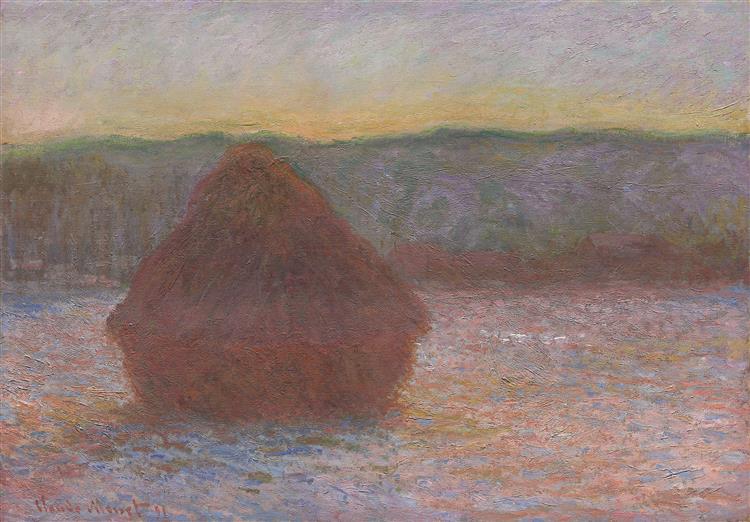Description
In "Stack of Wheat (Thaw - Sunset)", Claude Monet offers a poetic vision of nature that fuses the rural landscape and the changing light of dusk, a recurring theme in his work. Painted in 1891, this work is part of a series that Monet dedicated to stacks of wheat, highlighting not only the variability of light and color, but also the symbolism of abundance and seasonal transition.
The composition focuses on a mound of hay, which rises majestically in the foreground, suggesting the bounty of the harvest preceding the spring thaw. Monet uses the stacking of the wheat bundles to create a clear visual focus, drawing the viewer into the central part of the painting. The treatment of form is loose and almost abstract, revealing the imprint of loose, dynamic brushstrokes, a technique characteristic of Impressionism. This suggests not only the materiality of the wheat, but also the fragility of the moment; a reality that, like the seasons, is always in flux.
The colours chosen by Monet in this work are particularly evocative. Warm hues ranging from gold to orange dominate, with blue shadows appearing at the bottom and in the nooks between the hay bales. This palette not only captures the warmth of the sun at the end of the day, but also establishes a vibrant contrast with the freshness of the ice that begins to fade, symbolising the transition from the cold of winter to the promise of spring rebirth. This play of light and shadow reflects the influence of Impressionism in its quest to capture the fleeting nature of natural light in a short period of time and its ability to transform it into a visual experience.
It is worth mentioning that there are no human figures in this work, which emphasizes Monet’s connection to the natural environment. His choice to omit characters allows the viewer to focus on the relationship between light and form, and how this is reflected at a specific time of day. This approach, characteristic of his series of wheat stacks, suggests that the interaction between nature and art is a dialogue in which the viewer can immerse themselves visually, interpreting the scene through the emotional evocation that the painting generates.
Monet's technique and individualistic approach to landscape is celebrated in "Stack of Wheat (Thaw - Sunset)". It is a perfect example of Impressionism's radical drive toward the personal and the immediate, highlighting how a simple subject can be transformed into a space for meditation and contemplation. Monet, with his ability to reinterpret reality through an emotive lens, invites us to consider more than sight, offering a glimpse into the immediacy of the senses and the inexorable passage of time.
The work is an important part of Monet’s artistic engagements with light and nature, as well as with the seasonal changes that mark the cycle of agricultural life in France. In the context of his career, “Stack of Wheat (Thaw - Sunset)” stands as a reflection-provoking highlight of the passage of time and the cycle of life, themes that resonate in the work of many contemporary painters and continue to inspire later generations. The work is in the collection of the Art Institute of Chicago, where it continues to amaze visitors with its vibrant depiction of the natural world.
KUADROS ©, a famous painting on your wall.
Hand-made oil painting reproductions, with the quality of professional artists and the distinctive seal of KUADROS ©.
Painting reproduction service with satisfaction guarantee. If you are not completely satisfied with the replica of your painting, we will refund 100% of your money.

